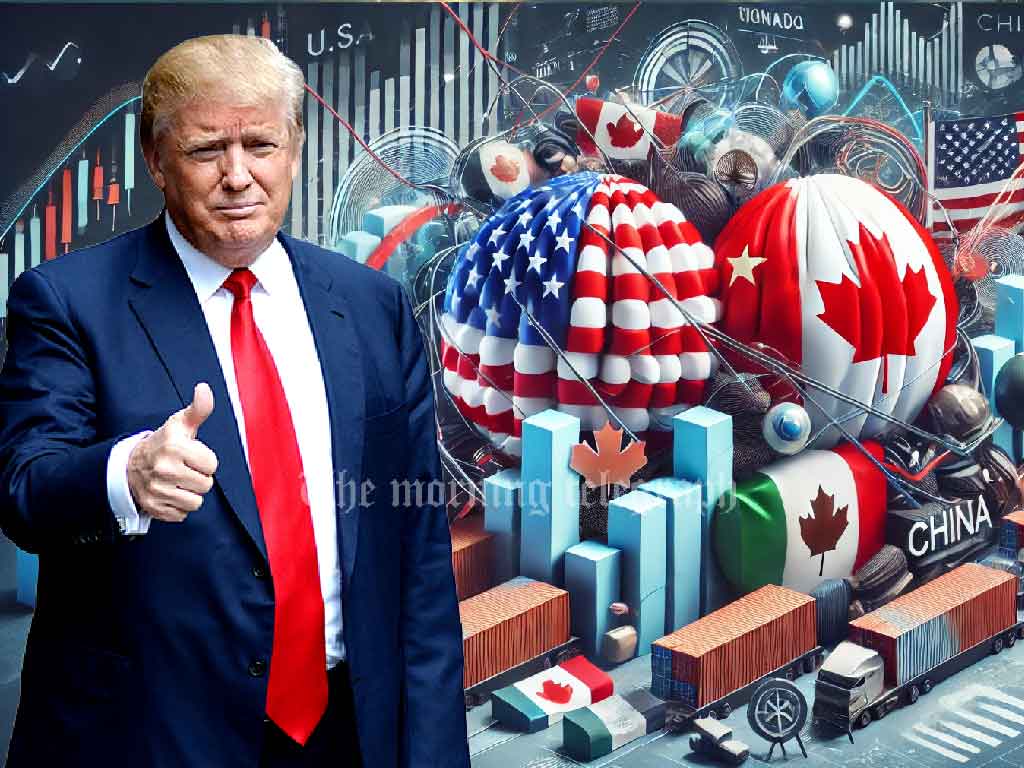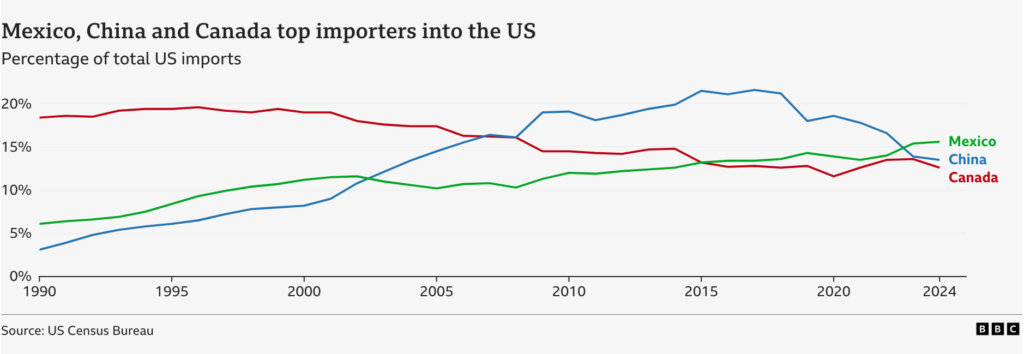
In a significant escalation of trade tensions, U.S. President Donald Trump has announced sweeping new tariffs on all goods imported from America’s three largest trading partners: China, Mexico, and Canada. The move, which takes effect on Tuesday, imposes a 25% tariff on imports from Canada and Mexico and an additional 10% tax on Chinese goods. Canadian energy products will face a lower 10% tariff.
The decision comes after Trump repeatedly threatened to impose tariffs unless the three countries addressed his concerns about illegal immigration and drug trafficking. Both Canada and Mexico have vowed to retaliate with their own tariffs, setting the stage for a potential trade war.
Tariffs as a Tool for Policy Change
Trump framed the tariffs as a necessary measure to hold China, Mexico, and Canada accountable for their roles in the flow of illegal drugs, particularly fentanyl, into the United States. In a statement posted on X (formerly Twitter), the White House said, “Today’s tariff announcement is necessary to hold China, Mexico, and Canada accountable for their promises to halt the flood of poisonous drugs into the United States.”
On his Truth Social platform, Trump cited the International Emergency Economic Powers Act (IEEPA) as the legal basis for the tariffs, calling illegal immigration and drug trafficking a “major threat” to U.S. citizens.
Tariffs, which are taxes levied on imported goods, have been a cornerstone of Trump’s economic strategy. He views them as a way to protect U.S. jobs, grow the economy, and pressure trading partners to align with U.S. policy goals.
Mexico and Canada Push Back
Mexico and Canada have strongly rejected the tariffs and announced plans to retaliate. Mexican President Claudia Sheinbaum dismissed allegations of her government’s “intolerable alliance” with drug cartels as “slander.” She emphasized that tariffs are not the solution to cross-border issues, stating, “Problems are not resolved by imposing tariffs, but by talking.”
Sheinbaum has instructed Mexico’s economy minister to implement retaliatory measures, including 25% tariffs on U.S. goods. She also called on the U.S. to address the illegal flow of firearms into Mexico, which arm drug cartels.
Canadian Prime Minister Justin Trudeau echoed similar sentiments, announcing that Canada will impose 25% tariffs on $155 billion worth of U.S. goods. An initial $30 billion in tariffs will take effect on Tuesday, with an additional $125 billion set to follow in 21 days. Targeted items include American beer, wine, bourbon, fruits, vegetables, clothing, and household appliances.
Trudeau rejected the notion that Canada poses a security threat to the U.S., noting that less than 1% of fentanyl entering the U.S. comes from Canada. He also highlighted Canada’s efforts to enhance border security, including a $1.3 billion investment in new measures.

China Condemns Tariffs, Vows Countermeasures
China, already subject to existing tariffs from the Trump and Biden administrations, expressed strong opposition to the new 10% levy. In a statement, the Chinese government said it was “strongly dissatisfied” and would file a lawsuit with the World Trade Organization (WTO) against the U.S. for its “wrongful practice.” China also vowed to take countermeasures to protect its interests.
Chinese Vice-Premier Ding Xuexiang, speaking at the World Economic Forum in Davos last month, had previously called for a “win-win” solution to trade tensions, emphasizing China’s desire to expand imports.
Economic Impact and Industry Concerns
The tariffs and subsequent retaliation could have far-reaching economic consequences. Canada, Mexico, and the U.S. share deeply integrated economies, with an estimated $2 billion worth of manufactured goods crossing their borders daily. Economists warn that the tariffs could raise prices on a wide range of products, from cars and lumber to food and alcohol.
The auto sector is particularly vulnerable, as auto parts often cross borders multiple times during production. TD Economics estimates that the average U.S. car price could increase by around $3,000 due to the tariffs.
A January report by the Peterson Institute for International Economics suggested that blanket 25% tariffs on Canada and Mexico would slow economic growth and accelerate inflation in all three countries.
U.S. industry groups have raised concerns about the potential fallout. The National Homebuilders Association warned that tariffs could increase housing costs, while Farmers for Free Trade cautioned that they would exacerbate challenges for struggling U.S. farmers. The U.S. Retail Industry Leaders Association, which includes major companies like Home Depot and Target, expressed hope that tariffs could still be averted.
Political Context and Future Prospects
The tariffs come at a politically charged moment, with Trump leveraging immigration and drug trafficking as key issues ahead of the 2024 presidential election. Ashley Davis, a Republican lobbyist representing major U.S. companies, suggested that Trump may scale back the tariffs if he can demonstrate progress on immigration and border security.
“Anything he can do to claim wins on [immigration and China], I think he’s going to do,” Davis told the BBC.
As the U.S., Canada, and Mexico prepare for a potential trade war, the immediate impact of the tariffs remains uncertain. However, one thing is clear: the move has further strained relations between the U.S. and its closest trading partners, with significant economic and political ramifications on the horizon.




